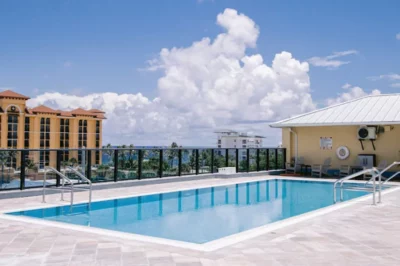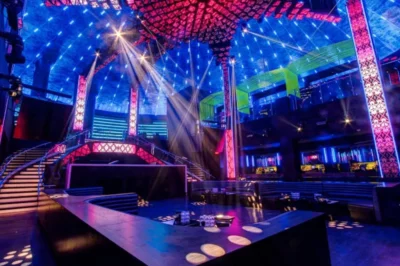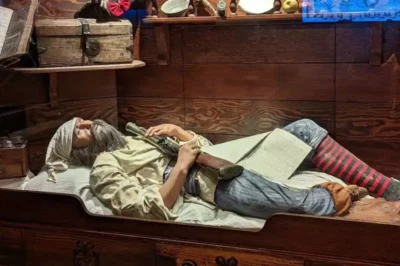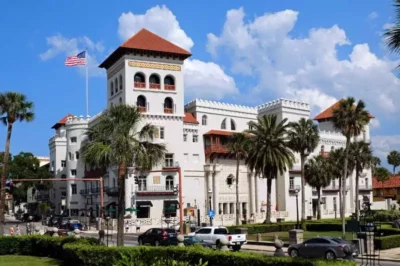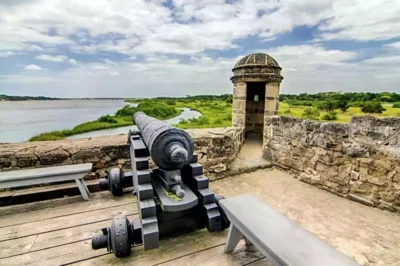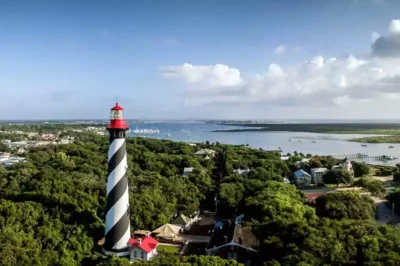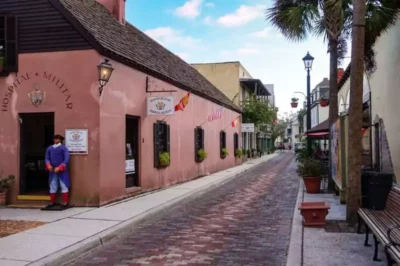- Villa Zorayda Museum History
- Architectural Wonders of Villa Zorayda Museum
- Exterior Highlights
- Interior Features
- The Collection and Exhibits
- Admission Fees and Hours
- Villa Zorayda Museum Wedding
- How to Get to Villa Zorayda Museum?
- FAQs
- What is the Villa Zorayda Museum?
- What architectural style is the Villa Zorayda Museum known for?
- Can I take a guided tour of the Villa Zorayda Museum?
- What unique artifacts can be found at the Villa Zorayda Museum?
- How did the Villa Zorayda Museum contribute to the local architecture?
Villa Zorayda Museum: A Moroccan Breeze in St Augustine
Nestled in the heart of historic St. Augustine, the oldest continuously inhabited European-established settlement in the United States, the Villa Zorayda Museum stands as a testament to the city’s rich and diverse past.
This architectural gem, inspired by the Alhambra palace in Granada, Spain, offers visitors a unique opportunity to explore an enchanting world of art, history, and culture.
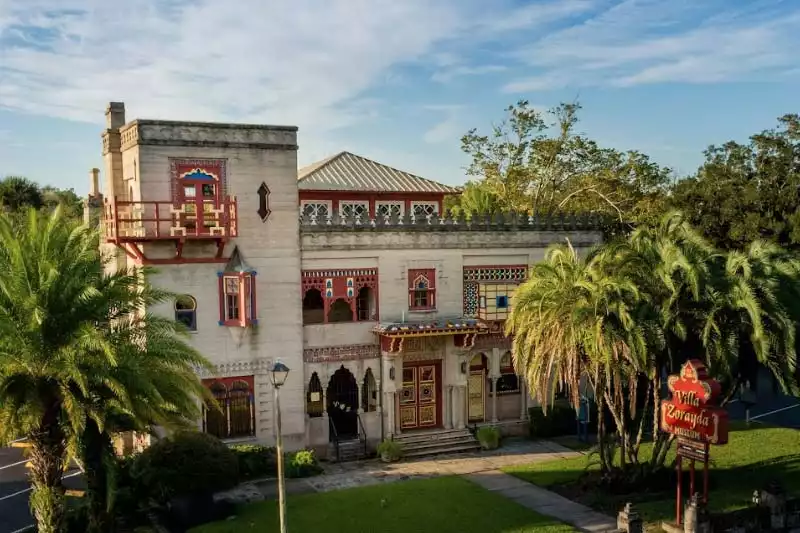
Villa Zorayda Museum History
The Villa Zorayda Museum owes its stunning design to the magnificent Alhambra palace in Granada, Spain. The Alhambra, a UNESCO World Heritage site, is renowned for its intricate architectural details, beautiful gardens, and captivating history.
The palace served as the inspiration for Villa Zorayda’s creator, Franklin W. Smith, who sought to bring the magic and beauty of the Alhambra to the shores of St. Augustine.
Franklin W. Smith, a Boston-based entrepreneur, and art collector, was the driving force behind the creation of Villa Zorayda. Enamored with the Moorish architecture of the Alhambra, Smith decided to replicate its unique design elements in his winter home in St. Augustine.
Constructed in 1883, Villa Zorayda became the first Moorish Revival style building in Florida, paving the way for many similar structures in the years to follow. This method of construction, utilizing poured concrete and crushed coquina, was innovative for its time and contributed significantly to the historical significance of the building.
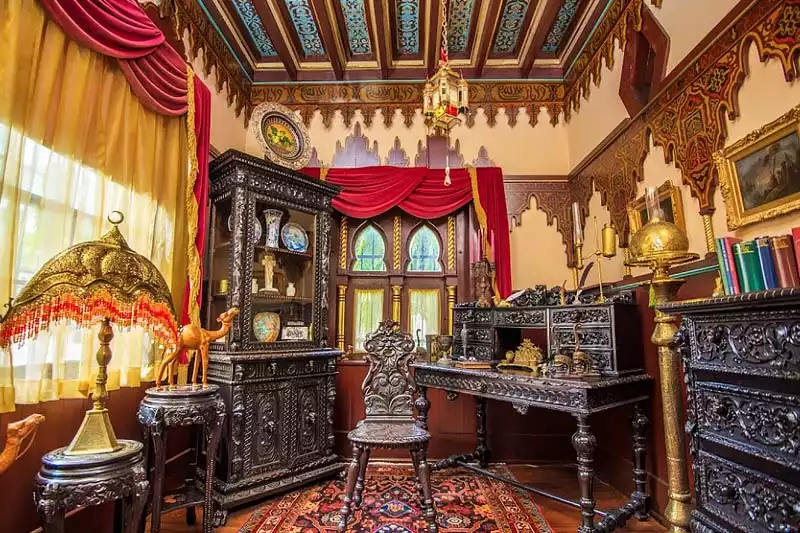
Throughout its long and storied history, Villa Zorayda has played various roles. Initially built as a private residence for Smith and his family, it eventually became a clubhouse for the exclusive Zorayda Club in 1913. The club welcomed prominent figures of the time, including Henry Flagler, an American industrialist and founder of the Florida East Coast Railway.
Later, in 1904, the villa was converted into a museum to house and display Smith’s extensive art and antique collection. Over the years, Villa Zorayda has continued to evolve, hosting weddings, events, and serving as a unique tourist attraction in St. Augustine.
Today, the museum is dedicated to preserving and sharing the history of Villa Zorayda and the treasures it holds within its walls, including being added to the U.S. National Register of Historic Places and featuring guided tours, audio tours, and candlelight tours for visitors to explore its rich history and architecture.
Architectural Wonders of Villa Zorayda Museum
The Villa Zorayda Museum is a prime example of Moorish Revival architecture, a style that emerged in the 19th century as a tribute to the intricate designs and opulence of the Moorish palaces in Spain and North Africa.
Some of the unique architectural features of the villa include horseshoe arches, ornate plasterwork, decorative tilework, and a stunning facade with intricate details.
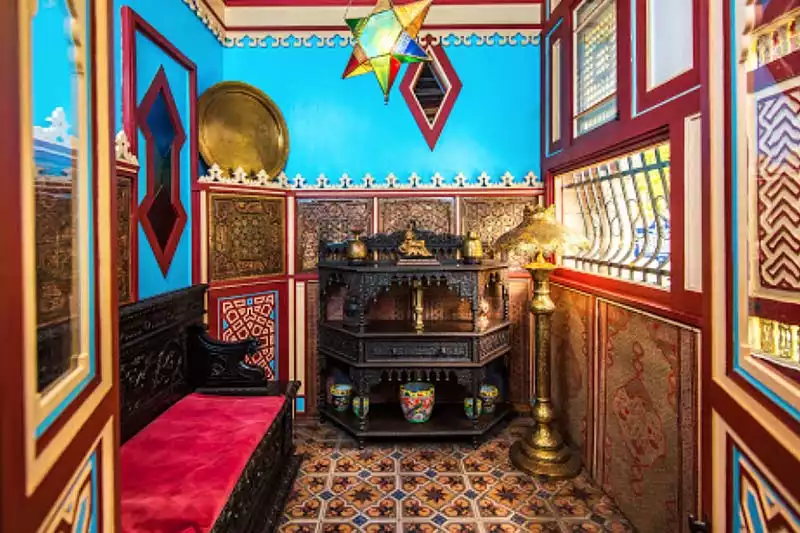
The interior of Villa Zorayda is equally mesmerizing, with beautifully carved wooden ceilings, a “Court of Lions” inspired staircase, and stunning stained-glass windows. The marriage of these exquisite features creates an ambiance that transports visitors to a bygone era of elegance and artistry.
While Moorish Spanish Revival architecture can be found throughout the United States, Villa Zorayda is exceptional in its fidelity to the original design elements of the Alhambra palace.
Many Moorish Revival buildings in the U.S., such as the Fox Theatre in Atlanta or the Tampa Bay Hotel in Florida, often combine the style with other architectural influences, like Beaux-Arts or Gothic Revival.
Villa Zorayda, however, maintains a more authentic representation of Moorish design, thanks to Franklin W. Smith’s dedication to replicating the captivating beauty of the Alhambra.
As such, the Villa Zorayda Museum offers a unique opportunity for visitors to experience the charm and allure of Moorish Revival architecture in its purest form, utilizing a method of construction of poured concrete that added durability and a distinctive texture to its appearance.
Exterior Highlights
The iconic façade: The exterior of Villa Zorayda Museum is a visual treat that showcases the splendor of Moorish Revival design. The iconic façade features a variety of intricately carved details, including horseshoe arches, geometric patterns, and stylized floral motifs.
These elements are a testament to the exquisite craftsmanship that went into the construction of the villa. The vibrant colors and textures of the façade captivate visitors, setting the stage for the wonders that await them inside.
The courtyard and fountain: As you enter the grounds of Villa Zorayda, you are greeted by a beautiful courtyard featuring a central fountain, reminiscent of those found in the Alhambra palace.
The courtyard is adorned with lush greenery, creating a serene and inviting atmosphere. This outdoor space not only provides a glimpse of the villa’s architectural beauty but also serves as a tranquil oasis for visitors to enjoy before or after their tour.
Interior Features
The grand music room: One of the most striking features of the Villa Zorayda Museum is its grand music room. This elegant space boasts high, intricately carved wooden ceilings, and stunning stained-glass windows that cast a kaleidoscope of colors across the room.
The room is further illuminated by hand-pierced brass lamps, adding a warm glow to the richly decorated interior. Among the treasures on display are oriental rugs and Egyptian artifacts, each telling a story of the distant lands from which they came. The music room was designed for entertaining and is adorned with antique furniture, musical instruments, artwork, and a notable “sacred cat rug”, further enhancing the ambiance of the space.
The “Court of Lions” inspired staircase: A key highlight of Villa Zorayda’s interior is the “Court of Lions” inspired staircase, which pays homage to the famous courtyard in the Alhambra palace. The staircase features a series of ornate columns and arches, as well as a central fountain surrounded by stone lions.
Alabaster details can be found throughout this area, adding to the opulence and beauty of the design. This exquisite design element not only showcases the skill of the craftsmen who built the villa but also serves as a visual reminder of the architectural influence behind Villa Zorayda.
As visitors ascend the staircase, they are transported to another time and place, further immersing themselves in the enchanting world of Villa Zorayda Museum.
The Collection and Exhibits
The Villa Zorayda Museum warmly welcomes you to explore its remarkable assortment of artifacts that encompass a range of time periods and cultures.
Showcasing the diverse interests of its founder, Franklin W. Smith, the museum presents an array of treasures, from breathtaking art and antiques and elegant furnishings to intriguing historical relics and oddities.
Visitors will be captivated by the unique stories behind items from Europe, the Middle East, Asia, and the Americas, all featured in the museum’s exhibits. Among these treasures is the priceless antique collections, including antique collections of both Franklin Smith and collections of both Franklin Smith, further enriched by the acquisitions made by Mussallem, an authority on oriental rugs and Egyptian artifacts.
The 2400-year-old Egyptian rug: One of the most remarkable items in Villa Zorayda’s collection is a 2400-year-old Egyptian rug, which is believed to be one of the oldest in existence.
Known as the “sacred cat rug”, this ancient artifact is made from the hair of ancient Egyptian cats and features intricate patterns and designs that showcase the skill and artistry of its creators. The rug offers a fascinating insight into the lives of ancient Egyptians and their reverence for cats, which were considered sacred animals.
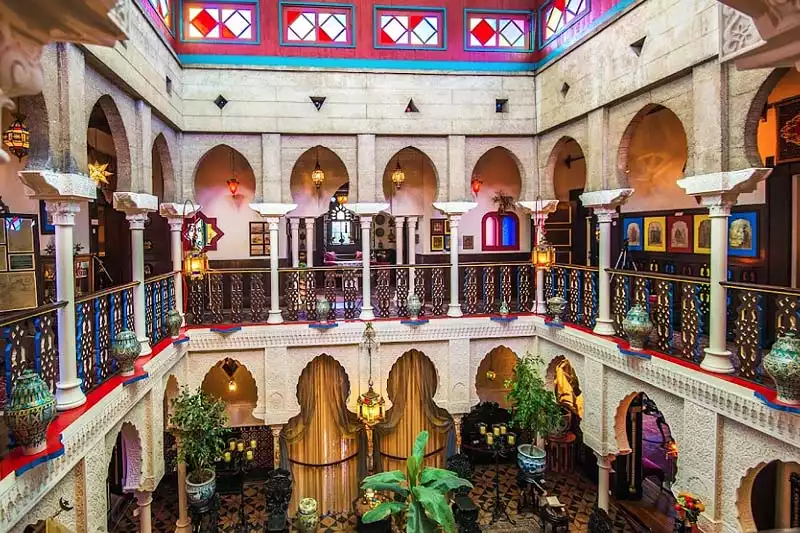
The sacred cat sarcophagus: Another notable piece in the museum’s collection is the sacred cat sarcophagus. This beautifully crafted artifact is made from intricately carved wood and was once used to house the mummified remains of a cat.
In ancient Egypt, cats were revered for their protective qualities and were often buried with their owners to provide guidance and companionship in the afterlife.
The sacred cat sarcophagus serves as a poignant reminder of the deep connection between humans and animals throughout history and the role they played in various cultures and belief systems.
Admission Fees and Hours
It’s always a good idea to visit the Villa Zorayda Museum’s official website to get the most current information on admission fees and hours of operation, as they may change from time to time. Generally, the museum is open Monday through Saturday from 10 a.m. to 5 p.m., and on Sundays from 11 a.m. to 4 p.m.
Villa Zorayda Museum Wedding
Villa Zorayda Museum, with its stunning architecture and enchanting atmosphere, makes for a unique and unforgettable wedding venue. The museum offers a one-of-a-kind backdrop for couples looking to celebrate their special day in a historic and romantic setting.
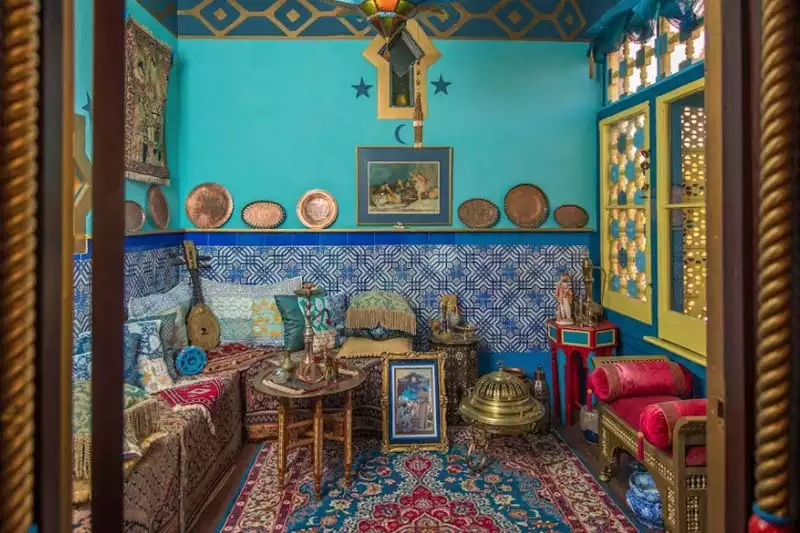
How to Get to Villa Zorayda Museum?
To get to Villa Zorayda Museum, located at 83 King Street in St. Augustine, Florida, you can use various modes of transportation:
- By car: If a car is at your disposal, reaching the museum should be a piece of cake. you can easily reach the museum by following the local road signs in St. Augustine’s historic district. There is ample parking available nearby, including street parking and public parking lots.
- By public transportation: Public transportation, the lifeblood of urban exploration! Carless, are we? Fear not! If you prefer to use public transportation, the Sunshine Bus Company operates several routes that serve St. Augustine’s historic district. Once you reach the historic district, the museum is within walking distance from the bus stops.
- Walking: For the ambulatory or pedal-powered among us, St. Augustine’s historic district is your oyster. Nestled in the heart of this storied enclave, the museum beckons! Hotels aplenty, attractions galore, all within a leisurely walk or invigorating bike ride. St. Augustine is a pedestrian and bike-friendly city with designated sidewalks and bike lanes.
FAQs
What is the Villa Zorayda Museum?
The Villa Zorayda Museum, built in 1883 in the heart of downtown St. Augustine, showcases the grand Gilded Age’s magnificent architecture. It was initially the winter residence of Franklin Smith, utilizing innovative construction methods with concrete and crushed coquina shell.
What architectural style is the Villa Zorayda Museum known for?
The museum is celebrated for its Moorish Spanish Revival style of architecture, set by Franklin Smith. This style set a precedence for architecture in St. Augustine, reflecting the intricate designs seen throughout the city today.
Can I take a guided tour of the Villa Zorayda Museum?
Yes, tours are available by reservation. Visitors can enjoy guided tours, self-guided audio tours, and special candlelight tours, offering an in-depth look at the historical significance of the building and its collections.
What unique artifacts can be found at the Villa Zorayda Museum?
Among its unique artifacts, the museum features the “Sacred Cat Rug,” made from the hairs of ancient cats that roamed the Nile River, and stunning stained glass, showcasing the diverse art and antiques collection still on display today.
How did the Villa Zorayda Museum contribute to the local architecture?
Franklin Smith’s method of construction using poured concrete and crushed coquina shell began the Moorish Spanish Revival architecture that is seen throughout St. Augustine today, marking a significant contribution to the city’s architectural heritage.
Conclusion
The Villa Zorayda Museum is a true gem nestled in the heart of St. Augustine, offering visitors a fascinating journey through time, art, and history. Its stunning Moorish Revival architecture and captivating collection of artifacts make it a must-see attraction for anyone visiting the city.
As you explore the enchanting rooms and corridors of Villa Zorayda, you’ll be transported to a bygone era, gaining a deeper appreciation for the diverse cultures and artistic expressions that have shaped our world.
So, when you find yourself in St. Augustine, be sure to add the Villa Zorayda Museum to your itinerary and experience the magic for yourself.


